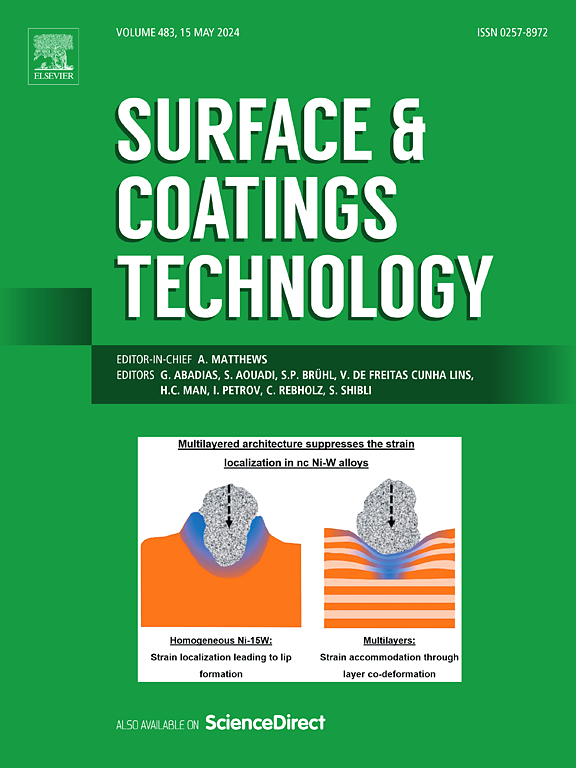Role of oxygen plasma for improved preparation of Cu/CNT Nanohybrids by RF sputtering
IF 5.3
2区 材料科学
Q1 MATERIALS SCIENCE, COATINGS & FILMS
引用次数: 0
Abstract
Carbon nanotubes (CNTs) decorated with nanoparticles (NPs) have unique properties as catalyst carriers in sustainable energy technologies. This study mainly focuses on the optimal dry-preparation of nanohybrids made of copper (Cu)-coated CNTs through a clean magnetron sputtering technique. A distinct approach of oxygen (O2) plasma surface functionalization is combined with the in-situ state of the deposition stage, either in static or in piezo-vibrating mode. The corresponding impact that controls the uniform deposition, chemical composition, and material loading was investigated. Dynamic light scattering (DLS) and Thermogravimetric analysis (TGA) were used to identify the best preparation conditions that impart the maximum surface modifications for improved hydrophilicity and material loading. The vibrating mode of the deposition stage continuously tumbles the CNTs during the sputtering and achieves all-around deposition. O2 plasma has played a crucial role in grafting the surface functional groups acting as nucleation centers and attracting the sputtered Cu species with stronger interaction. The findings emphasize the advantages of O2 plasma, particularly combined with vibrating mode for tailoring the surface properties and Cu loading at 1D nanoscale. These results demonstrated the versatility of the dry-synthesis technique, allowing the controlled preparation of high-purity nanohybrid powders with a scale-up potential.

氧等离子体在射频溅射制备Cu/CNT纳米杂化材料中的作用
纳米颗粒修饰的碳纳米管作为催化剂载体在可持续能源技术中具有独特的性能。本研究主要研究了通过干净磁控溅射技术制备铜(Cu)涂层碳纳米管纳米杂化物的最佳方法。一种独特的氧(O2)等离子体表面功能化方法与沉积阶段的原位状态相结合,无论是静态还是压电振动模式。研究了控制均匀沉积、化学成分和材料载荷的相应影响。采用动态光散射(DLS)和热重分析(TGA)确定了最佳制备条件,以获得最大的表面改性,从而提高亲水性和材料负载。沉积阶段的振动模式在溅射过程中不断翻滚CNTs,实现全方位沉积。O2等离子体在接枝作为成核中心的表面官能团和吸引具有较强相互作用的溅射Cu物质方面起着至关重要的作用。研究结果强调了O2等离子体的优势,特别是与振动模式相结合,可以定制一维纳米尺度的表面特性和Cu负载。这些结果证明了干法合成技术的多功能性,使高纯度纳米杂化粉末的可控制备具有扩大规模的潜力。
本文章由计算机程序翻译,如有差异,请以英文原文为准。
求助全文
约1分钟内获得全文
求助全文
来源期刊

Surface & Coatings Technology
工程技术-材料科学:膜
CiteScore
10.00
自引率
11.10%
发文量
921
审稿时长
19 days
期刊介绍:
Surface and Coatings Technology is an international archival journal publishing scientific papers on significant developments in surface and interface engineering to modify and improve the surface properties of materials for protection in demanding contact conditions or aggressive environments, or for enhanced functional performance. Contributions range from original scientific articles concerned with fundamental and applied aspects of research or direct applications of metallic, inorganic, organic and composite coatings, to invited reviews of current technology in specific areas. Papers submitted to this journal are expected to be in line with the following aspects in processes, and properties/performance:
A. Processes: Physical and chemical vapour deposition techniques, thermal and plasma spraying, surface modification by directed energy techniques such as ion, electron and laser beams, thermo-chemical treatment, wet chemical and electrochemical processes such as plating, sol-gel coating, anodization, plasma electrolytic oxidation, etc., but excluding painting.
B. Properties/performance: friction performance, wear resistance (e.g., abrasion, erosion, fretting, etc), corrosion and oxidation resistance, thermal protection, diffusion resistance, hydrophilicity/hydrophobicity, and properties relevant to smart materials behaviour and enhanced multifunctional performance for environmental, energy and medical applications, but excluding device aspects.
 求助内容:
求助内容: 应助结果提醒方式:
应助结果提醒方式:


